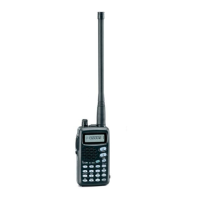How to unlock channels on my Icom Transceiver?
- Jjennifer67Jul 30, 2025
If the displayed channel on your Icom Transceiver cannot be selected, the lock function may be activated. To deactivate it, push [F], then push [7 (KEY LOCK)].

How to unlock channels on my Icom Transceiver?
If the displayed channel on your Icom Transceiver cannot be selected, the lock function may be activated. To deactivate it, push [F], then push [7 (KEY LOCK)].
How to fix Icom Transceiver when no power comes on?
If your Icom Transceiver doesn't power on, there are a couple of potential reasons. First, the battery might be completely drained, in which case you should recharge the battery pack. Alternatively, there might be a poor connection with the battery pack. Ensure that the connection to the transceiver is secure.
Why is there no sound coming from my Icom IC-A23 speaker?
If you cannot hear any sound from the speaker of your Icom Transceiver, the squelch level might be set too deep. Try adjusting the squelch to the threshold point. Also, check that the volume isn't too low by adjusting the [VOL] to a suitable level.
What to do if my Icom IC-A23 Transceiver is not transmitting?
If your Icom Transceiver is unable to transmit, it could be due to a couple of reasons. Some channels are receive-only, so try changing to a different channel. Alternatively, the battery might be exhausted, so try recharging the battery pack.
Why won't the scan start on my Icom Transceiver?
If the scan function on your Icom Transceiver does not start, it may be because not all memory channels are programmed as “TAG” channels. Set the “TAG” settings of the desired channels to resolve this.
How to turn on beep sounds on Icom IC-A23 Transceiver?
If you are not hearing any beep sounds on your Icom Transceiver, the beep tones may be turned OFF. To turn them back on, push [F], then push [8 (BEEP)] to adjust the beep tone level.
| Modulation | AM |
|---|---|
| Power Output | 5W / 1W |
| Battery Life | Approx. 10 hours |
| Number of Memory Channels | 200 |
| Channel Spacing | 25 kHz |
| Modulation System | AM |
| Spurious Emissions | Less than -60 dBc |
| Type | Airband Transceiver |
| Frequency Range | 118.000 - 136.975 MHz |
| Channels | 200 |
| Power Supply Requirement | 7.2 V DC |
| Current Drain | 1.5A |
| RF Output Power | 5 W |
| Dimensions | 58 × 135 × 36 mm |
| Weight (with battery) | 430g; 15.2oz (with BP-210N) |
Instructions for attaching the supplied antenna to the transceiver.
Instructions for attaching and removing the belt clip.
Detailed description of buttons, dials, indicators, and connectors on the transceiver.
Explanation of indicators and elements shown on the COM and NAV mode displays.
Covers dial functions, frequency setting, emergency access, and weather channels.
Adjusts squelch, side tone, beep tone, lock function, and backlight.
Explains low battery indicator and signal recording/playback.
Detailed procedures and precautions for receiving and transmitting signals.
How to select memory channels using the dial or keypad.
Procedure to copy memory channel data to frequency mode.
Step-by-step guide to storing frequencies and data into memory channels.
Assigning names to memory channels and clearing stored data.
Introduces the available scan types for the transceiver.
Procedures for scanning COM band frequencies and memory channels.
How to scan weather channels (U.S.A. version only).
Specifying channels to be included or skipped during scans.
Description of indicators related to VOR navigation on the display.
Details on using CDI and DVOR modes for navigation.
Procedure to select the next VOR station while using CDI mode.
Guidance on navigating to a VOR station using deviation indicators.
Setting a target course and verifying aircraft position using VOR stations.
Steps to set up frequencies for duplex operation.
How to activate and use the duplex transmit/receive feature.
Important safety and operational guidelines for charging.
Details on rapid charging with BC-119 and regular charging.
Operating period, pack life, and critical safety cautions for battery packs.
Procedure for transferring data between transceivers using a cable.
How to clone data to/from a PC using optional software and cable.
Covers frequency, mode, memory channels, power, temp. range, dimensions.
Details output power, modulation, and distortion characteristics.
Details sensitivity, selectivity, and audio output power.
Details on battery packs, charging periods, and operating times.
Information on wall chargers, DC cables, and cigarette lighter cables.
Instructions for connecting the OPC-967 headset adapter.
